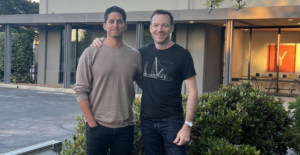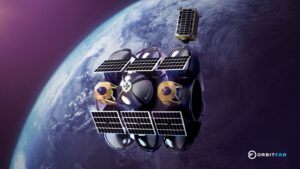Connecting the Dots | Identifying satellite UFOs
Tuesday, 25 October 2022 17:37
While tracking more and more objects orbiting Earth is crucial to ensure a safe operating environment, so is the ability to identify them correctly. Space-Track, provided by the U.S. Space Force’s 18th Space Squadron, offers one of the most comprehensive databases of orbital observations.
Array Labs raises $5 million for 3D-imagery constellation
Tuesday, 25 October 2022 16:56
Silicon Valley startup Array Labs raised $5 million in a pre-seed funding round backed by Seraphim Space and Agya Ventures, a real estate technology fund.
The post Array Labs raises $5 million for 3D-imagery constellation appeared first on SpaceNews.
Lucy spacecraft captures images of Earth, Moon ahead of gravity assist
Tuesday, 25 October 2022 16:06
NASA's Lucy spacecraft captured an image of the Earth on Oct 15, 2022, and an image of the Earth and the Moon on Oct.
Op-ed | Defending against near-peer adversaries requires a shift in collaboration between forces
Tuesday, 25 October 2022 15:10
With peer and near-peer adversaries accelerating their warfighting capabilities and becoming more aggressive, we need to reevaluate and rethink how to bring the capabilities of the intelligence community and the Pentagon together to keep them at bay.
Partial solar eclipse begins in Iceland headed towards India
Tuesday, 25 October 2022 13:54
A partial solar eclipse began over Iceland on Tuesday as the rare celestial spectacle started to make its way east across a swathe of the Northern Hemisphere.
The partial eclipse began at 0858 GMT and will end off the coast of India at 1302 GMT, crossing parts of Europe, North Africa and the Middle East on its way, according to the IMCCE institute of France's Paris Observatory.
Amateur astronomers must not stare directly at the eclipse, which will not darken the sky, and should instead wear protective glasses to avoid eye damage, experts said.
Solar eclipses occur when the Moon passes between the Sun and Earth, casting its shadow down onto our planet.
A total solar eclipse happens when the Moon completely blocks the Sun's disk, momentarily plunging a portion of the Earth into complete darkness.
Orbit Fab secures new investor to support satellite refueling efforts
Tuesday, 25 October 2022 12:00
Orbit Fab, a startup developing infrastructure for in-space refueling of satellites, announced Oct. 25 it lined up a new investor to support those plans.
The post Orbit Fab secures new investor to support satellite refueling efforts appeared first on SpaceNews.
Relativity Space maps path to Terran production at scale with 3D printers
Tuesday, 25 October 2022 11:05 Relativity Space, the first company to 3D print rockets and build the largest metal 3D printers in the world, today unveiled the latest iteration of its first-of-its-kind proprietary manufacturing platform, Stargate 4th Generation metal 3D printers. These printers will underpin both the development and rate production of Terran R, Relativity's fully reusable, 3D printed rocket that will be capab
Relativity Space, the first company to 3D print rockets and build the largest metal 3D printers in the world, today unveiled the latest iteration of its first-of-its-kind proprietary manufacturing platform, Stargate 4th Generation metal 3D printers. These printers will underpin both the development and rate production of Terran R, Relativity's fully reusable, 3D printed rocket that will be capab Planet launches nonprofit program to drive more access to timely, global satellite data
Tuesday, 25 October 2022 11:05 Planet Labs PBC (NYSE: PL)reports the launch of its Nonprofit Program, an offering that provides access to Planet imagery and support services specifically for nonprofits and non-governmental organizations (NGOS).
In line with Planet's mission to use space to help life on Earth and in effort to enable more impactful uses of Planet's data, the offering addresses two traditional challenges f
Planet Labs PBC (NYSE: PL)reports the launch of its Nonprofit Program, an offering that provides access to Planet imagery and support services specifically for nonprofits and non-governmental organizations (NGOS).
In line with Planet's mission to use space to help life on Earth and in effort to enable more impactful uses of Planet's data, the offering addresses two traditional challenges f Spacecraft manufacturer Apex emerges from stealth with $7.5M in funding
Tuesday, 25 October 2022 11:05 Apex, the Los Angeles-based spacecraft manufacturing company, emerged from stealth Monday with over $7.5M in funding.
As the cost to launch satellites and spacecraft to orbit has declined drastically over the last several years, an exponentially increasing number of new commercial and government payloads have entered operation.
These payloads, which range from earth observation camer
Apex, the Los Angeles-based spacecraft manufacturing company, emerged from stealth Monday with over $7.5M in funding.
As the cost to launch satellites and spacecraft to orbit has declined drastically over the last several years, an exponentially increasing number of new commercial and government payloads have entered operation.
These payloads, which range from earth observation camer Gilmour Space offers tech demo satellite mission from Australia in 2024
Tuesday, 25 October 2022 11:05 Australian rocket and satellite builder, Gilmour Space Technologies, is offering a new rideshare mission into Low Earth Orbit - this time, on one of its G-class satellite buses (or G-Sat) scheduled to be launched in late 2024.
"We're calling this our Kangaroo-1 mission, and it will be capable of carrying 125U (or 125 units) of payload volume into a mid-inclination orbit," said Shaun Kenyon
Australian rocket and satellite builder, Gilmour Space Technologies, is offering a new rideshare mission into Low Earth Orbit - this time, on one of its G-class satellite buses (or G-Sat) scheduled to be launched in late 2024.
"We're calling this our Kangaroo-1 mission, and it will be capable of carrying 125U (or 125 units) of payload volume into a mid-inclination orbit," said Shaun Kenyon Driving on the Sidewalk, MARDI-Style: Sols 3630-3632
Tuesday, 25 October 2022 11:05 We continue our drive through "Marker Band valley", an area of high interest scientifically, due to strong evidence of sulfates from orbital mapping. In this area, the sulfates are typically magnesium rich (think Epsom salts!), with less evidence for the more common calcium rich sulfates we have been traversing across for over ten years.
We found some lovely bedrock in our workspace this m
We continue our drive through "Marker Band valley", an area of high interest scientifically, due to strong evidence of sulfates from orbital mapping. In this area, the sulfates are typically magnesium rich (think Epsom salts!), with less evidence for the more common calcium rich sulfates we have been traversing across for over ten years.
We found some lovely bedrock in our workspace this m Discovery could dramatically narrow search for space creatures
Tuesday, 25 October 2022 11:05 An Earth-like planet orbiting an M dwarf - the most common type of star in the universe - appears to have no atmosphere at all. This discovery could cause a major shift in the search for life on other planets. Because M-dwarfs are so ubiquitous, this discovery means a large number of planets orbiting these stars may also lack atmospheres and therefore are unlikely to harbor living things.
An Earth-like planet orbiting an M dwarf - the most common type of star in the universe - appears to have no atmosphere at all. This discovery could cause a major shift in the search for life on other planets. Because M-dwarfs are so ubiquitous, this discovery means a large number of planets orbiting these stars may also lack atmospheres and therefore are unlikely to harbor living things. 'Marshmallow' world orbiting a cool red dwarf star
Tuesday, 25 October 2022 11:05 A gas giant exoplanet with the density of a marshmallow has been detected in orbit around a cool red dwarf star by a suite of instruments, including the NASA-funded NEID radial-velocity instrument on the WIYN 3.5-meter Telescope at Kitt Peak National Observatory, a Program of NSF's NOIRLab. The planet, named TOI-3757 b, is the fluffiest gas giant planet ever discovered around this type of star.
A gas giant exoplanet with the density of a marshmallow has been detected in orbit around a cool red dwarf star by a suite of instruments, including the NASA-funded NEID radial-velocity instrument on the WIYN 3.5-meter Telescope at Kitt Peak National Observatory, a Program of NSF's NOIRLab. The planet, named TOI-3757 b, is the fluffiest gas giant planet ever discovered around this type of star. Using Webb Telescope to study supernovae as source of heavy elements in universe
Tuesday, 25 October 2022 11:05 In 1980's popular book "Cosmos," Carl Sagan wrote of what makes us: "All the elements of the Earth except hydrogen and some helium have been cooked by a kind of stellar alchemy billions of years ago in stars, some of which are today inconspicuous white dwarfs on the other side of the Milky Way Galaxy. The nitrogen in our DNA, the calcium in our teeth, the iron in our blood, the carbon in our app
In 1980's popular book "Cosmos," Carl Sagan wrote of what makes us: "All the elements of the Earth except hydrogen and some helium have been cooked by a kind of stellar alchemy billions of years ago in stars, some of which are today inconspicuous white dwarfs on the other side of the Milky Way Galaxy. The nitrogen in our DNA, the calcium in our teeth, the iron in our blood, the carbon in our app The most precise accounting yet of dark energy and dark matter
Tuesday, 25 October 2022 11:05 Astrophysicists have performed a powerful new analysis that places the most precise limits yet on the composition and evolution of the universe. With this analysis, dubbed Pantheon+, cosmologists find themselves at a crossroads. Pantheon+ convincingly finds that the cosmos is composed of about two-thirds dark energy and one-third matter - mostly in the form of dark matter - and is expanding at a
Astrophysicists have performed a powerful new analysis that places the most precise limits yet on the composition and evolution of the universe. With this analysis, dubbed Pantheon+, cosmologists find themselves at a crossroads. Pantheon+ convincingly finds that the cosmos is composed of about two-thirds dark energy and one-third matter - mostly in the form of dark matter - and is expanding at a 
